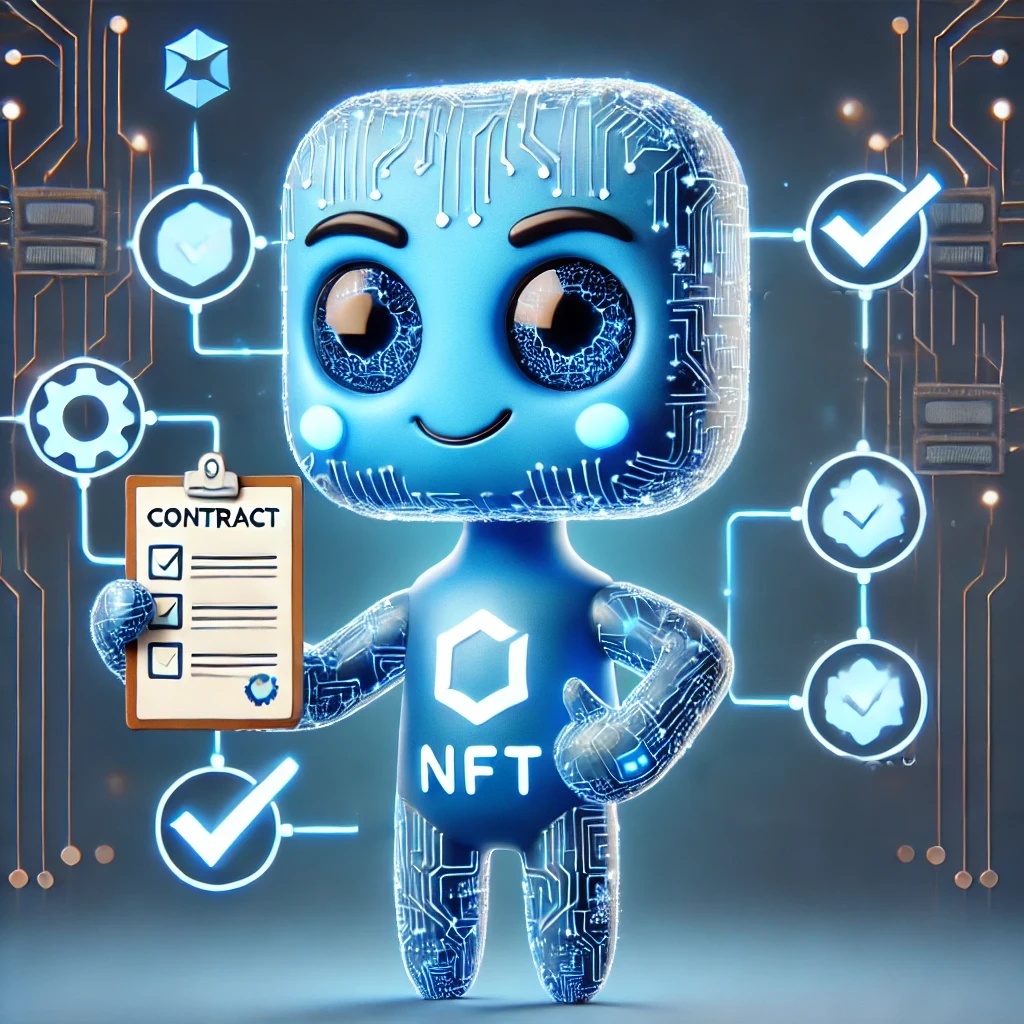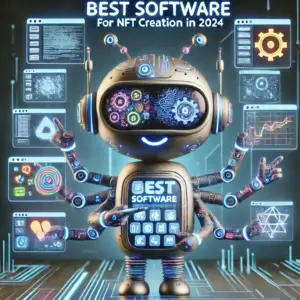In the dynamic landscape of blockchain technology, Non-Fungible Tokens (NFTs) have emerged as a revolutionary force, transforming the way we perceive and interact with digital assets. At the heart of this phenomenon lie NFT smart contracts, intricate pieces of code that govern the creation, ownership, and transfer of these unique digital tokens. While NFTs themselves often capture the limelight, it’s the underlying smart contracts that orchestrate their functionality and security.
This comprehensive guide delves into the realm of NFT smart contracts, offering a deep dive into their intricacies, functionalities, benefits, and the pivotal role they play in the burgeoning NFT ecosystem. We’ll unravel the complexities of smart contracts, explore their applications in the NFT space, and discuss the challenges they present.
Table of Contents:
- Understanding NFT Smart Contracts: The Building Blocks of Digital Ownership
- Key Benefits of NFT Smart Contracts
- Common NFT Smart Contract Architectures
- Exploring NFT Smart Contract Use Cases
- Challenges and Considerations with NFT Smart Contracts
- Developing and Deploying NFT Smart Contracts: Key Steps
- Best Practices for Secure NFT Smart Contracts
- Conclusion
- Q&A
Understanding NFT Smart Contracts: The Building Blocks of Digital Ownership
To grasp the essence of NFT smart contracts, it’s crucial to first understand the concept of smart contracts themselves. In essence, a smart contract is a self-executing agreement that resides on a blockchain. Unlike traditional contracts, which rely on intermediaries to enforce terms, smart contracts operate autonomously, eliminating the need for trust in third parties and ensuring immutability.
When it comes to NFTs, smart contracts act as the bedrock of their existence, defining their characteristics and behavior. These contracts are programmed to manage essential aspects of NFTs, including:
- Creation and Minting: Smart contracts establish the blueprint for creating new NFTs, defining their unique attributes, such as metadata, images, and limited supply. The act of generating an NFT from this blueprint is known as “minting.”
- Ownership and Transfer: NFT smart contracts track the ownership history of each token, recording every transaction and ensuring that the ownership rights are transparent and secure. Transfers between wallets are seamlessly executed through the contract, eliminating the need for intermediaries.
- Royalty Fees: Some NFT smart contracts allow creators to specify royalty fees, which are a percentage of every secondary sale of their NFTs. This mechanism enables artists to receive continuous revenue from their creations.
- Metadata: Smart contracts can store metadata associated with an NFT, including its description, attributes, provenance, and even external links to websites or content. This metadata enriches the NFT’s utility and provides important information about its history.
- Access Control: NFT smart contracts can implement access control mechanisms to restrict certain actions, allowing creators to define who can trade, burn, or modify an NFT. This gives them granular control over their creations.
- Use Cases: Smart contracts can enable various use cases for NFTs beyond mere digital ownership. For example, they can be used to create access tokens for exclusive events, membership benefits, or unlock special features in games.
Key Benefits of NFT Smart Contracts
The use of smart contracts for NFTs brings forth numerous advantages that have propelled their adoption and transformed the digital asset landscape.
- Decentralization and Transparency: NFT smart contracts reside on a distributed ledger, making them impervious to manipulation or censorship. All transactions and ownership records are publicly auditable, fostering transparency and accountability.
- Security and Immutability: Once deployed on a blockchain, NFT smart contracts are immutable, meaning they cannot be altered or deleted. This ensures the authenticity and integrity of NFT data, protecting owners from fraud and counterfeiting.
- Automation and Efficiency: Smart contracts automate crucial NFT processes, eliminating the need for intermediaries and streamlining transactions. This expedites the transfer of ownership, reduces errors, and increases overall efficiency.
- Programmable Logic: NFT smart contracts can be programmed with complex functionalities, including royalties, access control, and custom logic, empowering creators to design unique and innovative NFT experiences.
- Global Accessibility: NFTs and their underlying smart contracts are accessible globally, enabling ownership and transfer of digital assets across borders without any geographical limitations.
Common NFT Smart Contract Architectures
While the core principles of NFT smart contracts remain consistent, their implementation can vary depending on the chosen blockchain and development approaches. Here are some prevalent architectures used in NFT smart contracts:
- ERC-721: This standard, established on the Ethereum blockchain, defines the core functionalities of non-fungible tokens. It encompasses the creation, ownership, and transfer of unique digital assets. It is widely adopted and has been the foundation for countless NFT projects.
- ERC-1155: This standard offers an extension to ERC-721, enabling the creation and management of both single and multiple NFTs within a single contract. It efficiently handles the creation and transfer of batches of NFTs, making it ideal for projects with multiple asset types or collections.
- Multi-Contract Architectures: Some NFT projects utilize a multi-contract approach, splitting functionalities across different smart contracts. For instance, one contract might handle NFT minting, while another focuses on royalty distribution. This modularity can enhance flexibility and scalability.
Exploring NFT Smart Contract Use Cases
The versatility of NFT smart contracts has opened doors to a vast range of use cases beyond just digital art and collectibles. Here are some prominent examples:
Digital Art and Collectibles
This remains the most prominent use case for NFTs. Artists, musicians, and photographers can leverage NFT smart contracts to securely mint and sell their digital creations, establishing verifiable ownership and enabling royalty payments for future sales. This opens up new revenue streams for creators and fosters a more equitable model for the art market.
Gaming
NFTs are revolutionizing the gaming industry by enabling players to own in-game items, such as characters, weapons, and virtual lands. Smart contracts ensure the authenticity of these assets, preventing duplication and manipulation, and allow players to trade them on marketplaces, creating a thriving digital economy within games.
Music and Entertainment
Musicians and entertainers can use NFTs to sell exclusive content, such as unreleased tracks, behind-the-scenes footage, or access to virtual concerts. NFTs can also represent fractional ownership of intellectual property, allowing fans to invest in their favorite artists.
Identity and Access Control
NFTs have the potential to revolutionize identity management and access control. They can represent verified identities, granting access to secure systems or exclusive communities. NFTs can also be used to manage permissions and privileges within organizations.
Supply Chain Management
NFTs can track the provenance and authenticity of physical goods throughout the supply chain. From raw materials to finished products, NFTs can record vital information, enabling tamper-proof tracking and reducing the risk of counterfeiting.
Real Estate
NFTs can facilitate the fractional ownership of real estate, allowing individuals to invest in properties without owning the entire asset. Smart contracts can manage the distribution of rental income and other property rights.
Digital Tickets and Event Management
NFTs can act as digital tickets, ensuring authenticity and preventing counterfeiting. They can also be programmed with unique benefits, such as access to exclusive content or merchandise.
Challenges and Considerations with NFT Smart Contracts
While NFT smart contracts offer substantial benefits, they also present challenges that need careful consideration.
- Security Risks: Like any software, smart contracts are susceptible to vulnerabilities. Bugs or malicious code can lead to hacks or exploits, resulting in the loss of NFTs or assets.
- Scalability: Blockchain networks can face scalability issues, particularly during periods of high transaction volume. This can lead to congestion and delays in NFT transactions, impacting user experience.
- Gas Fees: Using smart contracts on blockchains often incurs transaction fees, known as “gas fees,” which can vary significantly. High gas fees can make NFT transactions expensive, particularly for small-value NFTs.
- Legal and Regulatory Uncertainty: The regulatory framework surrounding NFTs is still evolving, leading to legal uncertainty about ownership, taxation, and other aspects. Navigating these complexities is crucial for both creators and NFT platforms.
- Lack of Interoperability: Different blockchains and NFT standards may lack interoperability, meaning NFTs created on one chain may not be transferable to another. This fragmentation can limit the market for NFTs.
- Environmental Concerns: Some blockchains, particularly proof-of-work chains like Bitcoin, have high energy consumption associated with mining. While NFT projects are increasingly moving to more energy-efficient blockchains, environmental concerns remain a relevant topic.
Developing and Deploying NFT Smart Contracts: Key Steps
Creating and deploying NFT smart contracts involves a series of steps that require technical expertise.
- Choose a Blockchain: Select a blockchain that aligns with your project requirements, considering factors such as gas fees, security, and community support. Ethereum, Solana, Flow, and Tezos are popular choices for NFTs.
- Design Your Smart Contract: Define the functionalities and logic of your NFT smart contract, taking into account factors such as minting, ownership, royalties, and access controls. Make sure to thoroughly test your contract before deployment.
- Choose a Development Language: Select a programming language compatible with your chosen blockchain. Solidity is the standard language for Ethereum smart contracts, while other blockchains have their own languages.
- Use a Development Environment: Set up a development environment with the necessary tools and libraries to write, test, and deploy your smart contract. Popular tools include Remix, Truffle, and Hardhat.
- Deploy Your Smart Contract: Once your contract is ready, deploy it to your chosen blockchain using a suitable deployment method. You might require a wallet with sufficient funds to cover deployment costs.
- Test Thoroughly: After deployment, conduct rigorous testing to ensure your smart contract functions as expected and is secure.
Best Practices for Secure NFT Smart Contracts
Security is paramount for NFT smart contracts, as any vulnerabilities can compromise the integrity of your NFTs and their assets.
- Thorough Auditing: Engage independent security auditors to review your smart contract for potential vulnerabilities before deployment. Experienced auditors can identify and address potential weaknesses, safeguarding your project from attacks.
- Use Established Standards: Adhere to established standards, such as ERC-721 or ERC-1155, to ensure compatibility with industry best practices and reduce the risk of errors.
- Minimize Complexity: Keep your smart contracts as simple and concise as possible, focusing on essential functionalities. Complex code can introduce hidden vulnerabilities that are harder to detect.
- Use Robust Libraries: Leverage well-tested and proven libraries, such as OpenZeppelin, to handle common functionalities, reducing the need for custom code and minimizing security risks.
- Implement Gas Optimization: Optimize your smart contract for gas efficiency to reduce transaction costs and improve overall performance. Excessive gas consumption can make NFT transactions expensive and dissuade users.
Conclusion
NFT smart contracts are the invisible yet powerful drivers behind the burgeoning NFT ecosystem. They provide the foundation for the creation, ownership, and transfer of unique digital assets, ushering in a new era of digital ownership. While challenges exist, the benefits of decentralized, transparent, and programmable contracts are undeniable. As the NFT landscape continues to evolve, it’s crucial to understand these powerful pieces of code and their role in shaping the future of digital assets.
Q&A
What are NFT smart contracts?
NFT smart contracts are pieces of code that reside on a blockchain and govern the creation, ownership, and transfer of non-fungible tokens (NFTs). They are self-executing agreements that automate key functions related to NFTs, such as minting, ownership tracking, and royalty payments.
How do NFT smart contracts work?
NFT smart contracts operate on a blockchain, using a set of predefined rules to execute specific actions. When an NFT is minted, the smart contract records its details, including unique attributes, ownership, and metadata. Transactions involving the NFT are automatically executed on the blockchain, ensuring transparency and security.
What are the benefits of using NFT smart contracts?
NFT smart contracts offer numerous benefits, including decentralization, transparency, security, automation, programmable logic, and global accessibility. They enable secure ownership, verifiable provenance, and innovative use cases for NFTs.
What are some common NFT smart contract architectures?
Popular NFT smart contract architectures include ERC-721, ERC-1155, and multi-contract architectures. ERC-721 is the foundational standard for single NFTs, while ERC-1155 allows for the management of multiple NFTs within a single contract. Multi-contract architectures divide functionalities among different contracts for enhanced flexibility and scalability.
What are some use cases for NFT smart contracts beyond digital art?
NFT smart contracts have applications in gaming, music and entertainment, identity management, supply chain management, real estate, and event ticketing. They enable the tokenization and secure management of digital and physical assets, creating new opportunities in diverse industries.
What are the challenges associated with NFT smart contracts?
Challenges include security risks, scalability limitations, gas fees, legal and regulatory uncertainty, lack of interoperability, and environmental concerns related to some blockchains. Proper understanding and mitigation of these challenges are crucial for the sustainable growth of the NFT ecosystem.
How can I develop and deploy my own NFT smart contract?
Developing an NFT smart contract involves choosing a blockchain, designing the contract, selecting a development language, using a suitable development environment, deploying the contract, and conducting comprehensive testing. Expertise in blockchain development and programming languages is required for this process.
What are some best practices for secure NFT smart contracts?
Best practices include thorough auditing by independent security professionals, using established standards, minimizing code complexity, leveraging robust libraries, and optimizing for gas efficiency. These measures help to mitigate security risks and enhance the reliability of NFT smart contracts.






